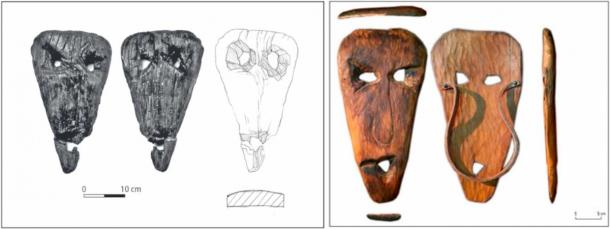
Mask or Masquerade? Skeptic Totally ‘Trashes’ Magical Pagan Masks
For over six decades, it was believed that two wooden objects discovered in Opole, Poland were pagan Slavic masks used in mystical ceremonies held in cemetery woods. However, recent research by a Polish professor challenges this dogmatic interpretation and suggests they were simply discarded waste.
Demystifying Ancient Magic Masks
In the 1960s, Polish archaeologists uncovered a medieval fortress in the city of Opole on the Oder River, which was once the capital of Upper Silesia. Two wooden objects were found and thought to be “ritual masks” utilised by Slavs during clandestine Pagan celebrations.
Professor Kamil Kajkowski leads the art and history department at the West Kashubian Museum in Bytów, Poland. In 2021, Kajkowski published his findings in the journal “Archeologia Polski.” The scientist not only downplayed the mystical significance of the alleged “masks”, but he went so far as to classify them as mere rubbish.
- Half A Million Dollar Mask With Otherworldly Origins
- 10 Sacred Masks for Hunting, Ritual, Shame and Death
Measuring Up Controversy
The first of the two wooden ‘masks’ was a crafted pine board measuring approximately 34 centimeters (almost 13.5 inches) in length, and 20 centimeters (7.87 in) at its widest, with varying thickness between 3.7 to 5.3 centimeters (1.45 to 2.08 in).
This mask was found in a garbage layer sandwiched between two 11th-century structures. Upon discovery of this artifact, archaeologist Helena Cehak-Hołubowiczowa recognized holes in the board as resembling eyes and a mouth, and a line down the center as a depiction of a nose. She has certainly got a point. But was this another case of pareidolia - seeing faces where they don’t intentionally exist?
The second, smaller artifact was made of birch and measured 22.86 centimeters (9 in) length and 17.78 centimeters (7 in) at its widest. This artifact was discovered in a 12th-century building, the inside of was sanded smooth, and it also had three holes, and it was interpreted similarly to the first by Cehak-Hołubowiczowa, as a pagan mask.
- 16 Bizarre, Impressive and Hilarious Funerary Masks of the Ancient World
- 16 Creepy Masks Made from Real Human Skulls

Left, Opole-Ostrówek, wooden “mask” from the 3rd quarter of the 11th century. Right, modern reproduction of the same. Sławomir Uta/ Kamil Kajkowski, “Masks from Opole in the context of Medieval Slavic rites”, (Archaeologia Polski 66, 2021, fig.11/CC BY 4.0)
Forbidden “Godless” Ancient Games
According to Haaretz, Helena Cehak-Hołubowiczowa believed the masks were used in Christmas celebrations because one of the masks was found near two wooden goat figurines, and she identified ethnographic accounts of Christmas customs and carols from Poland that lasted until the late 19th or early 20th century.
The common assumption is that in ancient times masks were used in rituals to facilitate communication with the gods, spirits, and animals, but this is just a speculation. Professor Kamil Kajkowski points out that there is only one historical record from the time when the supposed masks were made, which was written by Czech chronicler Kosmas in 1092 AD. Kosmas described a pagan funeral tradition performed in rural cemeteries and open fields, where "godless games" were played while wearing masks and invoking the spirits of the dead”.
Suppressing the Godless
Professor Kamil Kajkowski questions whether the masked performances in churchyards were actually a continuation of pre-Christian rituals. He also asked whether the clergy who participated in the rituals understood the masks to have pagan significance or not. The researcher also raises questions about whether the rites described by Kosmas in the 11th century were the same that the church targeted in the 13th century, and whether any of those rituals had anything to do with the stronghold of Opole where the masks were found.
According to Kajkowski, during another dig in Wrocław in 1985, two wooden objects were found in a pit between two buildings. These were also interpreted as masks due to their similarity to the so-called "masks" from Opole, and their proximity to zoomorphic figurines. However, Kajkowski argues that the location of the objects in a garbage layer and the absence of any means of attaching the object to the face, “casts doubt on their identification as masks”.
When Magic Gets Totally Trashed
Kajkowski notes that if these two objects were indeed masks they would have been cumbersome and would have impaired the wearer's breathing and vision. Furthermore, the researcher discovered that the supposed "nose line" were tunnels made by bark beetles. Kajkowski further suggests that the objects could simply have been “toys or unfinished figurines discarded by a child or artist”.
Kajkowski concluded that the two well-known Polish objects, if not ritual masks, could be ordinary items used in daily life, such “as pieces of furniture, parts of toys, rocking horse seats, or work tools like a stool.” According to the researcher, just because the exact purpose of the objects is unknown, it doesn't automatically make them ceremonial items, which he says is a common mistake in archaeology, ie. if the purpose is unknown, mark it as ‘ritual’.
Top image: Opole-Ostrówek, wooden "mask" from the mid-12th century. (Karol Szott/Kamil Kajkowski, "Masks from Opole in the context of Medieval Slavic rites", Archaeologia Polski 66, 2021, fig.3) Source: Archaeologia Polski/ CC BY 4.0
By Ashley Cowie
















Comments
We need a LOT MORE of this type of debunking. But the problem becomes, after you remove all the bunk from ancient history, ...is there anything left?
Nobody gets paid to tell the truth.